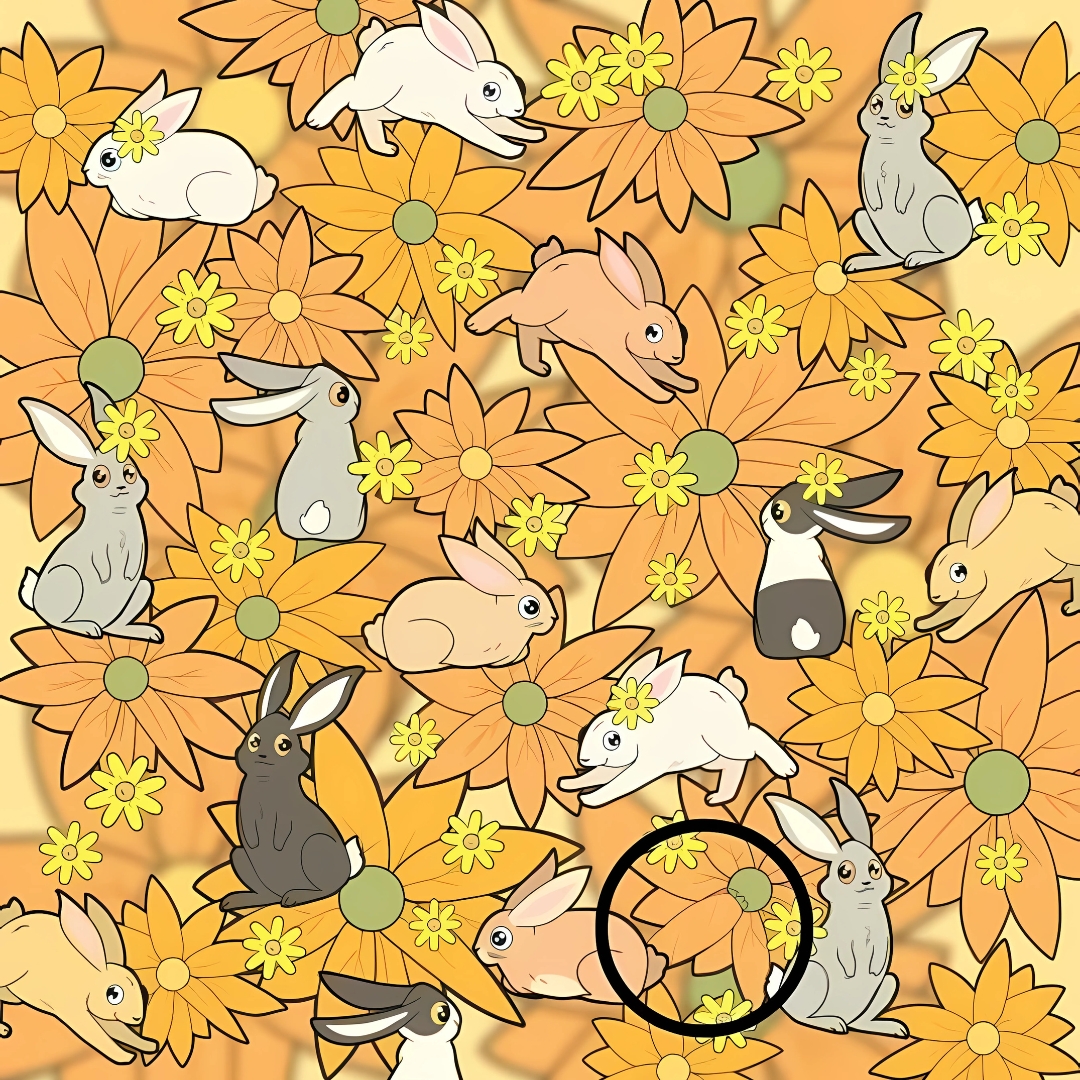Hidden Carrot :Optical illusions have captivated human minds for centuries, serving as windows into the complex workings of our visual perception system.
Among the most popular contemporary forms of these visual puzzles are “find the hidden object” challenges, where viewers must locate concealed items within seemingly ordinary images within a specified time frame.
These challenges, such as finding a hidden carrot in seven seconds, represent far more than simple entertainment—they offer profound insights into how our brains process visual information and make sense of the world around us.
The Foundation of Visual Perception
To understand why optical illusion challenges work so effectively, we must first examine the fundamental processes of human visual perception. When light enters our eyes, it strikes the retina and converts into electrical signals that travel through the optic nerve to various regions of the brain.
However, what we “see” is not simply a direct recording of these signals. Instead, our brain actively constructs our visual experience by interpreting, filtering, and sometimes filling in missing information based on previous experiences, expectations, and cognitive patterns.
This construction process happens so quickly and automatically that we rarely notice it occurring. Our brains constantly make assumptions about what we’re seeing, using shortcuts and pattern recognition to help us navigate the world efficiently.

These mental shortcuts, while generally helpful, create opportunities for visual illusions to exploit the gaps between what exists in reality and what our brain interprets as reality.
The visual cortex, located in the occipital lobe at the back of our brain, plays a crucial role in processing visual information. Different areas within this region specialize in detecting specific features such as edges, colors, movement, and shapes.
When we encounter a hidden object challenge, these specialized areas must work together to separate the target item from its background—a process that becomes increasingly difficult when the hidden object has been cleverly camouflaged or integrated into the surrounding visual elements.
The Psychology of Pattern Recognition
Human beings are exceptional pattern recognition machines. This ability served our ancestors well, allowing them to quickly identify predators, locate food sources, and navigate complex environments. However, this same pattern recognition system can work against us in optical illusion challenges.
Our brains tend to see what they expect to see, often overlooking details that don’t fit established patterns or expectations.
When confronted with a “find the hidden carrot” challenge, our brain immediately begins searching for carrot-like shapes, colors, and patterns. If the hidden carrot has been designed to blend seamlessly with its surroundings or has been stylistically altered to appear as something else, our pattern recognition system may skip right over it. This phenomenon explains why some people can stare directly at a hidden object for extended periods without recognizing it, while others spot it almost immediately.
The concept of “perceptual set” plays a significant role in these challenges. A perceptual set refers to our tendency to perceive things in a particular way based on our expectations, experiences, and current mental state. If we expect to find a bright orange carrot, we may overlook a carrot that has been rendered in unexpected colors or integrated into a pattern where its traditional shape is disguised.
Attention and Visual Search Strategies
Time-limited optical illusion challenges, such as seven-second hidden object puzzles, test not only our visual perception abilities but also our attention control and search strategies. Research in cognitive psychology has identified several different approaches people use when searching for targets in complex visual scenes.
Some individuals employ a systematic scanning strategy, methodically examining the image from left to right or top to bottom. This approach can be thorough but may not be optimal for time-limited challenges. Others use a more random or intuitive approach, allowing their eyes to jump to areas that seem most likely to contain the hidden object. This strategy can be faster but may result in missing the target if it’s located in an unexpected area.
The most successful approach often involves a combination of both strategies—beginning with a quick overall scan to get a sense of the image’s composition, followed by more focused attention on areas that seem most promising. Understanding these different approaches can help individuals improve their performance on optical illusion challenges.
The Role of Cognitive Flexibility
Cognitive flexibility—the ability to adapt our thinking and approach when initial strategies prove unsuccessful—is crucial for solving challenging optical illusions. When our first attempt to locate a hidden object fails, we must be willing to abandon our initial assumptions and try new approaches. This might involve looking for different shapes, considering alternative color schemes, or examining areas of the image we initially dismissed.
Some hidden object challenges deliberately exploit common assumptions to make the search more difficult. For example, a hidden carrot might be oriented vertically rather than horizontally, partially obscured by other objects, or rendered in grayscale rather than its typical orange color. Successful solvers learn to question their assumptions and remain open to unexpected possibilities.
The Neuroscience of Visual Attention
Modern neuroscience research has revealed fascinating insights into how our brains handle visual attention during tasks like hidden object searches. Functional magnetic resonance imaging (fMRI) studies show that multiple brain regions activate during these challenges, including areas responsible for visual processing, attention control, and executive function.
The parietal cortex, in particular, plays a crucial role in directing visual attention and helping us focus on relevant parts of an image while filtering out distracting elements. When we successfully locate a hidden object, there’s typically a measurable increase in activity in this region, along with enhanced communication between different brain areas involved in visual processing.
Interestingly, research has also shown that the moment of discovery—when a hidden object suddenly becomes visible—activates reward centers in the brain, releasing dopamine and creating a sense of satisfaction. This neurochemical response helps explain why optical illusion challenges can be so addictive and enjoyable.
Training Visual Perception Skills
Regular engagement with optical illusion challenges can actually improve various aspects of visual perception and cognitive function. Like physical exercise strengthens muscles, mental exercises involving visual search and pattern recognition can enhance our brain’s processing capabilities.
Studies have shown that individuals who regularly engage with visual puzzles demonstrate improved performance in tasks requiring sustained attention, visual discrimination, and spatial reasoning. These benefits extend beyond puzzle-solving and can enhance performance in real-world activities such as driving, sports, and professional tasks requiring visual attention to detail.
For those looking to improve their hidden object detection abilities, several strategies can be helpful. First, practice maintaining a relaxed yet focused state of attention rather than straining to find the hidden object. Tension often interferes with the natural pattern recognition processes. Second, vary your search approach by sometimes focusing on details and other times taking in the whole image. Third, consider the possible ways the hidden object might be disguised—it might be rotated, partially hidden, colored differently, or integrated into a larger pattern.
The Cultural and Social Aspects
Optical illusion challenges have become a significant part of contemporary digital culture, spreading rapidly through social media platforms and generating millions of shares and comments. This phenomenon reflects our fundamental human desire to test our abilities against others and share experiences of discovery and accomplishment.
The social sharing aspect of these challenges adds an interesting dimension to their appeal. When someone successfully finds a hidden object, they often experience a desire to share their success with others, contributing to the viral nature of these puzzles. Conversely, when someone struggles to find the hidden object, they may seek help from friends or family members, creating opportunities for social interaction and collaboration.
Implications for Learning and Development
Understanding the principles behind optical illusion challenges has important implications for education and cognitive development. Teachers and educational designers can use these insights to create more effective learning materials that capture attention and engage students’ visual processing systems.
For children, age-appropriate hidden object games can help develop crucial visual perception skills that support reading, mathematics, and other academic subjects. The key is to provide challenges that are difficult enough to be engaging but not so difficult as to cause frustration.
Optical Illusion Answer

Future Directions and Applications
As our understanding of visual perception and optical illusions continues to advance, new applications are emerging in fields ranging from medical diagnosis to user interface design. Researchers are exploring how insights from optical illusion research can improve medical imaging analysis, helping radiologists more quickly and accurately identify abnormalities in X-rays, MRIs, and other diagnostic images.
In the realm of technology, understanding how our brains process visual information is informing the development of better artificial intelligence systems for image recognition and computer vision applications. The challenges that optical illusions present to human perception often reveal similar limitations in artificial systems, providing valuable insights for improving machine learning algorithms.
The continued popularity of optical illusion challenges reflects their unique ability to simultaneously entertain, educate, and reveal fundamental aspects of human cognition. Whether searching for a hidden carrot in seven seconds or tackling more complex visual puzzles, these challenges offer a fascinating glimpse into the remarkable capabilities and limitations of our visual perception system. As we continue to unravel the mysteries of how our brains construct our visual reality, optical illusions will undoubtedly remain valuable tools for both scientific research and popular entertainment.

